traction control MITSUBISHI OUTLANDER PHEV 2018 Owner's Manual (in English)
[x] Cancel search | Manufacturer: MITSUBISHI, Model Year: 2018, Model line: OUTLANDER PHEV, Model: MITSUBISHI OUTLANDER PHEV 2018Pages: 538, PDF Size: 25.01 MB
Page 235 of 538
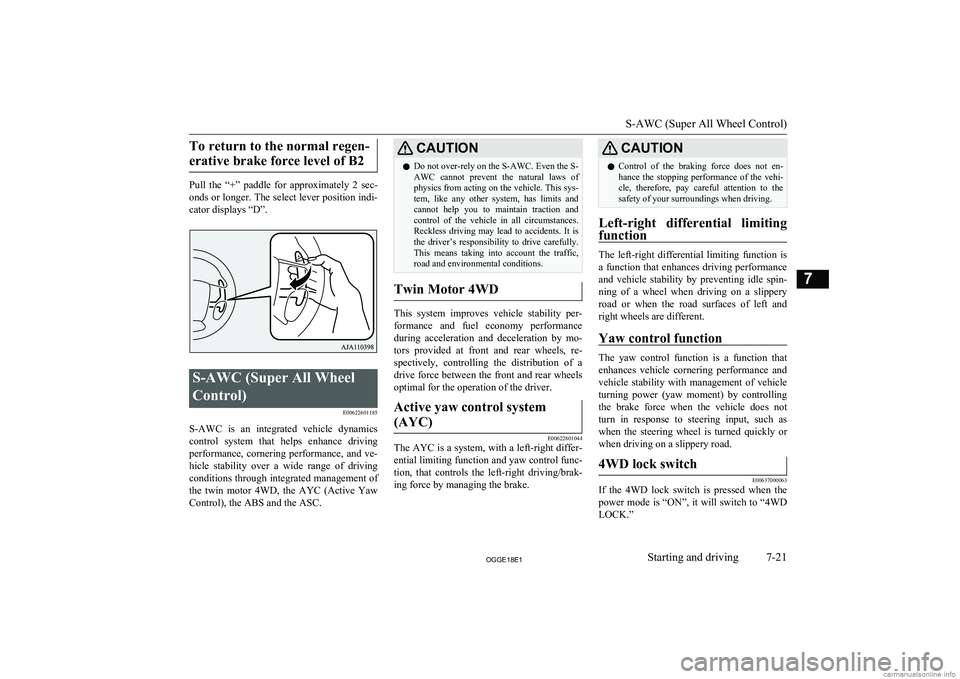
To return to the normal regen-erative brake force level of B2
Pull the “+” paddle for approximately 2 sec-
onds or longer. The select lever position indi-
cator displays “D”.
S-AWC (Super All Wheel
Control) E00622601185
S-AWC is an integrated vehicle dynamics
control system that helps enhance driving
performance, cornering performance, and ve-
hicle stability over a wide range of driving conditions through integrated management of the twin motor 4WD, the AYC (Active Yaw
Control), the ABS and the ASC.
CAUTIONl Do not over-rely on the S-AWC. Even the S-
AWC cannot prevent the natural laws of
physics from acting on the vehicle. This sys- tem, like any other system, has limits and
cannot help you to maintain traction and
control of the vehicle in all circumstances. Reckless driving may lead to accidents. It is the driver’s responsibility to drive carefully.
This means taking into account the traffic,
road and environmental conditions.
Twin Motor 4WD
This system improves vehicle stability per-
formance and fuel economy performanceduring acceleration and deceleration by mo-
tors provided at front and rear wheels, re- spectively, controlling the distribution of a
drive force between the front and rear wheels optimal for the operation of the driver.
Active yaw control system
(AYC)
E00622801044
The AYC is a system, with a left-right differ- ential limiting function and yaw control func-
tion, that controls the left-right driving/brak-
ing force by managing the brake.
CAUTIONl Control of the braking force does not en-
hance the stopping performance of the vehi-
cle, therefore, pay careful attention to the safety of your surroundings when driving.
Left-right differential limiting
function
The left-right differential limiting function is
a function that enhances driving performance and vehicle stability by preventing idle spin-
ning of a wheel when driving on a slippery road or when the road surfaces of left andright wheels are different.
Yaw control function
The yaw control function is a function thatenhances vehicle cornering performance and vehicle stability with management of vehicle
turning power (yaw moment) by controlling the brake force when the vehicle does not
turn in response to steering input, such as
when the steering wheel is turned quickly or when driving on a slippery road.
4WD lock switch
E00637000063
If the 4WD lock switch is pressed when the
power mode is “ON”, it will switch to “4WD LOCK.”
S-AWC (Super All Wheel Control)
7-21OGGE18E1Starting and driving7
Page 236 of 538
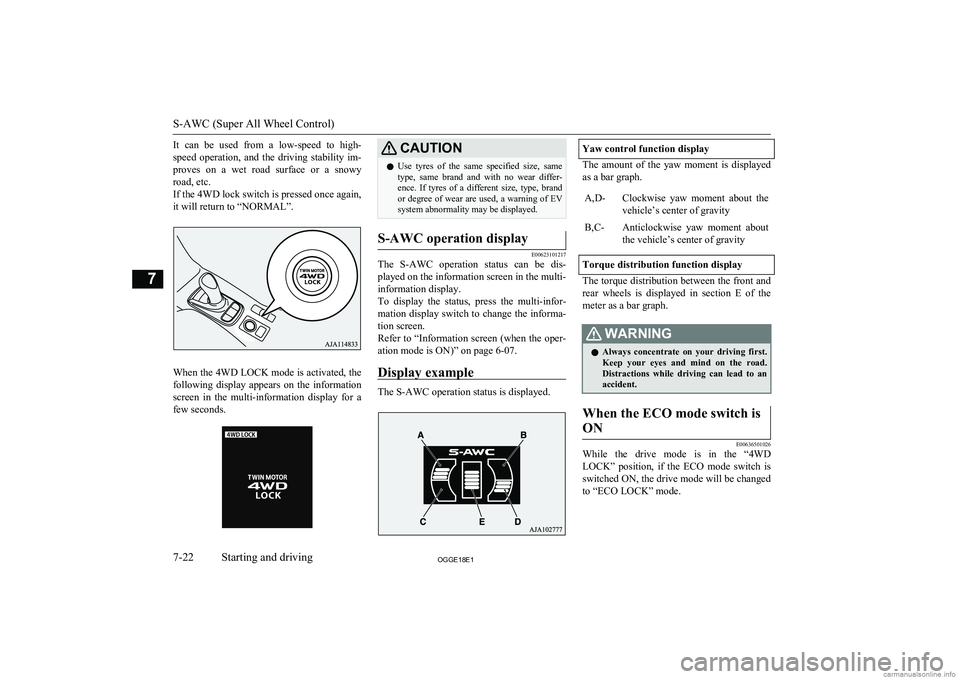
It can be used from a low-speed to high-speed operation, and the driving stability im-
proves on a wet road surface or a snowy road, etc.
If the 4WD lock switch is pressed once again, it will return to “NORMAL”.
When the 4WD LOCK mode is activated, the
following display appears on the information
screen in the multi-information display for a few seconds.
CAUTIONl Use tyres of the same specified size, same
type, same brand and with no wear differ- ence. If tyres of a different size, type, brandor degree of wear are used, a warning of EVsystem abnormality may be displayed.S-AWC operation display
E00623101217
The S-AWC operation status can be dis-
played on the information screen in the multi-
information display.
To display the status, press the multi-infor-
mation display switch to change the informa- tion screen.
Refer to “Information screen (when the oper- ation mode is ON)” on page 6-07.
Display example
The S-AWC operation status is displayed.
Yaw control function display
The amount of the yaw moment is displayed
as a bar graph.
A,D-Clockwise yaw moment about the vehicle’s center of gravityB,C-Anticlockwise yaw moment about
the vehicle’s center of gravity
Torque distribution function display
The torque distribution between the front and rear wheels is displayed in section E of the
meter as a bar graph.
WARNINGl Always concentrate on your driving first.
Keep your eyes and mind on the road.
Distractions while driving can lead to an accident.When the ECO mode switch is
ON
E00636501026
While the drive mode is in the “4WD
LOCK” position, if the ECO mode switch is switched ON, the drive mode will be changed to “ECO LOCK” mode.
S-AWC (Super All Wheel Control)
7-22OGGE18E1Starting and driving7
Page 237 of 538
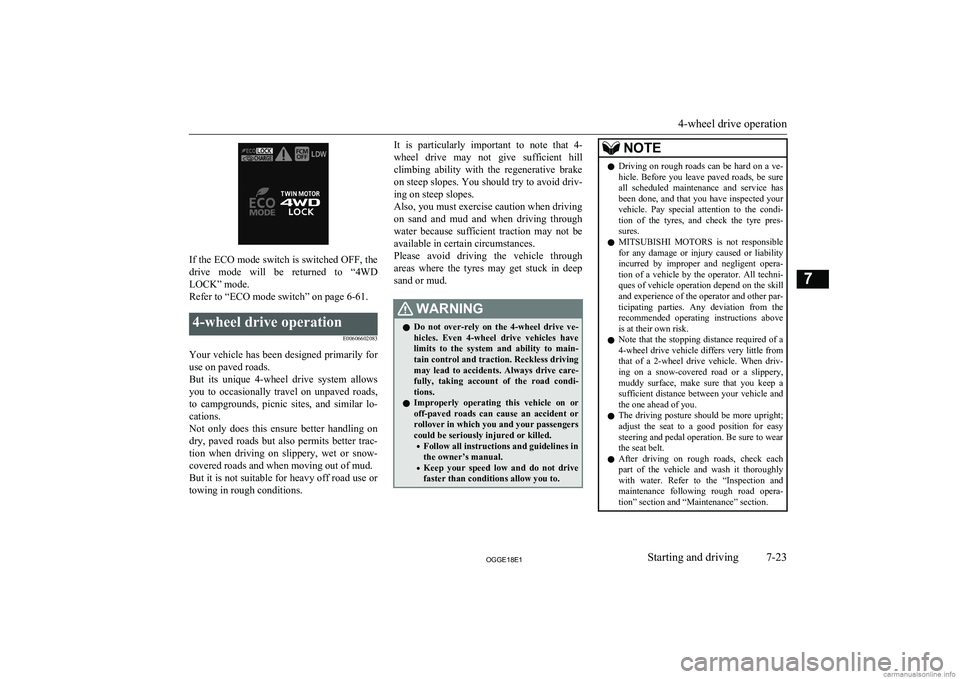
If the ECO mode switch is switched OFF, the
drive mode will be returned to “4WD LOCK” mode.
Refer to “ECO mode switch” on page 6-61.
4-wheel drive operation
E00606602083
Your vehicle has been designed primarily foruse on paved roads.
But its unique 4-wheel drive system allows
you to occasionally travel on unpaved roads, to campgrounds, picnic sites, and similar lo-
cations.
Not only does this ensure better handling on
dry, paved roads but also permits better trac-
tion when driving on slippery, wet or snow- covered roads and when moving out of mud.
But it is not suitable for heavy off road use or
towing in rough conditions.
It is particularly important to note that 4-
wheel drive may not give sufficient hill
climbing ability with the regenerative brake on steep slopes. You should try to avoid driv- ing on steep slopes.
Also, you must exercise caution when driving on sand and mud and when driving through
water because sufficient traction may not be
available in certain circumstances.
Please avoid driving the vehicle through
areas where the tyres may get stuck in deep sand or mud.WARNINGl Do not over-rely on the 4-wheel drive ve-
hicles. Even 4-wheel drive vehicles have
limits to the system and ability to main- tain control and traction. Reckless driving may lead to accidents. Always drive care-
fully, taking account of the road condi-
tions.
l Improperly operating this vehicle on or
off-paved roads can cause an accident or
rollover in which you and your passengers
could be seriously injured or killed.
• Follow all instructions and guidelines in
the owner’s manual.
• Keep your speed low and do not drive
faster than conditions allow you to.NOTEl Driving on rough roads can be hard on a ve-
hicle. Before you leave paved roads, be sure all scheduled maintenance and service has
been done, and that you have inspected your vehicle. Pay special attention to the condi- tion of the tyres, and check the tyre pres-
sures.
l MITSUBISHI
MOTORS is not responsible
for any damage or injury caused or liability
incurred by improper and negligent opera- tion of a vehicle by the operator. All techni-
ques of vehicle operation depend on the skill and experience of the operator and other par- ticipating parties. Any deviation from the
recommended operating instructions above is at their own risk.
l Note that the stopping distance required of a
4-wheel drive vehicle differs very little from
that of a 2-wheel drive vehicle. When driv- ing on a snow-covered road or a slippery,muddy surface, make sure that you keep a
sufficient distance between your vehicle and
the one ahead of you.
l The driving posture should be more upright;
adjust the seat to a good position for easy steering and pedal operation. Be sure to wear
the seat belt.
l After driving on rough roads, check each
part of the vehicle and wash it thoroughlywith water. Refer to the “Inspection andmaintenance following rough road opera-
tion” section and “Maintenance” section.
4-wheel drive operation
7-23OGGE18E1Starting and driving7
Page 250 of 538
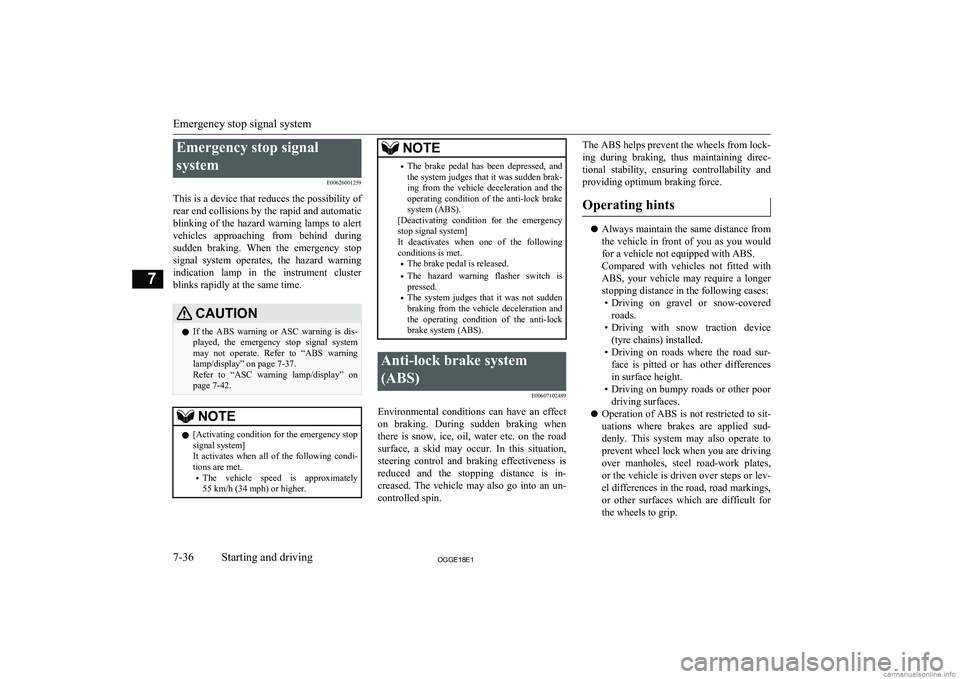
Emergency stop signal
system E00626001259
This is a device that reduces the possibility of rear end collisions by the rapid and automatic blinking of the hazard warning lamps to alert
vehicles approaching from behind during sudden braking. When the emergency stop
signal system operates, the hazard warning indication lamp in the instrument cluster
blinks rapidly at the same time.CAUTIONl If the ABS warning or ASC warning is dis-
played, the emergency stop signal system may not operate. Refer to “ABS warning
lamp/display” on page 7-37.
Refer to “ASC warning lamp/display” on page 7-42.NOTEl [Activating condition for the emergency stop
signal system]
It activates when all of the following condi-
tions are met.
• The vehicle speed is approximately
55 km/h (34 mph) or higher.NOTE• The brake pedal has been depressed, and
the system judges that it was sudden brak- ing from the vehicle deceleration and theoperating condition of the anti-lock brake
system (ABS).
[Deactivating condition for the emergency
stop signal system]
It deactivates when one of the following conditions is met.
• The brake pedal is released.
• The hazard warning flasher switch is
pressed.
• The system judges that it was not sudden
braking from the vehicle deceleration and
the operating condition of the anti-lock
brake system (ABS).Anti-lock brake system
(ABS) E00607102489
Environmental conditions can have an effect
on braking. During sudden braking when there is snow, ice, oil, water etc. on the road
surface, a skid may occur. In this situation, steering control and braking effectiveness is
reduced and the stopping distance is in-
creased. The vehicle may also go into an un- controlled spin.
The ABS helps prevent the wheels from lock-
ing during braking, thus maintaining direc-
tional stability, ensuring controllability and
providing optimum braking force.
Operating hints
l Always maintain the same distance from
the vehicle in front of you as you would for a vehicle not equipped with ABS.
Compared with vehicles not fitted with ABS, your vehicle may require a longer
stopping distance in the following cases: • Driving on gravel or snow-covered
roads.
• Driving with snow traction device
(tyre chains) installed.
• Driving on roads where the road sur-
face is pitted or has other differences in surface height.
• Driving on bumpy roads or other poor
driving surfaces.
l Operation of ABS is not restricted to sit-
uations where brakes are applied sud-
denly. This system may also operate to
prevent wheel lock when you are driving over manholes, steel road-work plates,
or the vehicle is driven over steps or lev-
el differences in the road, road markings, or other surfaces which are difficult for
the wheels to grip.
Emergency stop signal system
7-36OGGE18E1Starting and driving7
Page 254 of 538
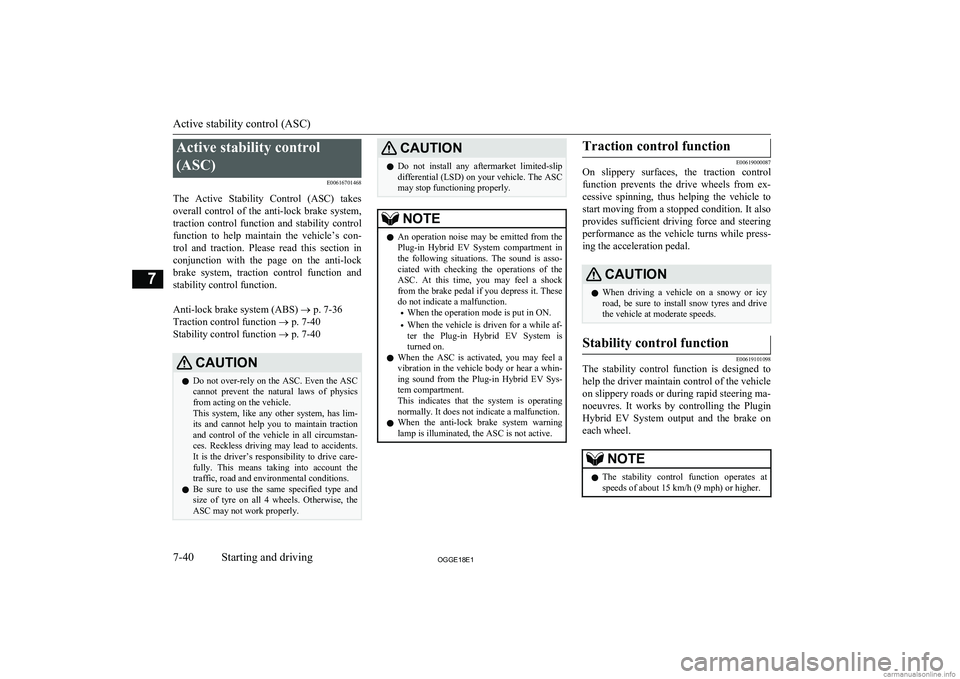
Active stability control
(ASC) E00616701468
The Active Stability Control (ASC) takes
overall control of the anti-lock brake system, traction control function and stability control
function to help maintain the vehicle’s con-
trol and traction. Please read this section in conjunction with the page on the anti-lock
brake system, traction control function and stability control function.
Anti-lock brake system (ABS) ® p. 7-36
Traction control function ® p. 7-40
Stability control function ® p. 7-40CAUTIONl Do not over-rely on the ASC. Even the ASC
cannot prevent the natural laws of physics
from acting on the vehicle.
This system, like any other system, has lim-
its and cannot help you to maintain traction and control of the vehicle in all circumstan- ces. Reckless driving may lead to accidents. It is the driver’s responsibility to drive care-
fully. This means taking into account the traffic, road and environmental conditions.
l Be sure to use the same specified type and
size of tyre on all 4 wheels. Otherwise, the ASC may not work properly.CAUTIONl Do not install any aftermarket limited-slip
differential (LSD) on your vehicle. The ASC
may stop functioning properly.NOTEl An operation noise may be emitted from the
Plug-in Hybrid EV System compartment in
the following situations. The sound is asso- ciated with checking the operations of the ASC. At this time, you may feel a shock
from the brake pedal if you depress it. These
do not indicate a malfunction.
• When the operation mode is put in ON.
• When the vehicle is driven for a while af-
ter the Plug-in Hybrid EV System is
turned on.
l When the ASC is activated, you may feel a
vibration in the vehicle body or hear a whin-
ing sound from the Plug-in Hybrid EV Sys- tem compartment.
This indicates that the system is operating normally. It does not indicate a malfunction.
l When the anti-lock brake system warning
lamp is illuminated, the ASC is not active.Traction control function
E00619000087
On slippery surfaces, the traction control
function prevents the drive wheels from ex-
cessive spinning, thus helping the vehicle to
start moving from a stopped condition. It also
provides sufficient driving force and steering performance as the vehicle turns while press-
ing the acceleration pedal.
CAUTIONl When driving a vehicle on a snowy or icy
road, be sure to install snow tyres and drive
the vehicle at moderate speeds.Stability control function
E00619101098
The stability control function is designed to
help the driver maintain control of the vehicle
on slippery roads or during rapid steering ma-
noeuvres. It works by controlling the Plugin
Hybrid EV System output and the brake on
each wheel.
NOTEl The stability control function operates at
speeds of about 15 km/h (9 mph) or higher.
Active stability control (ASC)
7-40OGGE18E1Starting and driving7
Page 255 of 538
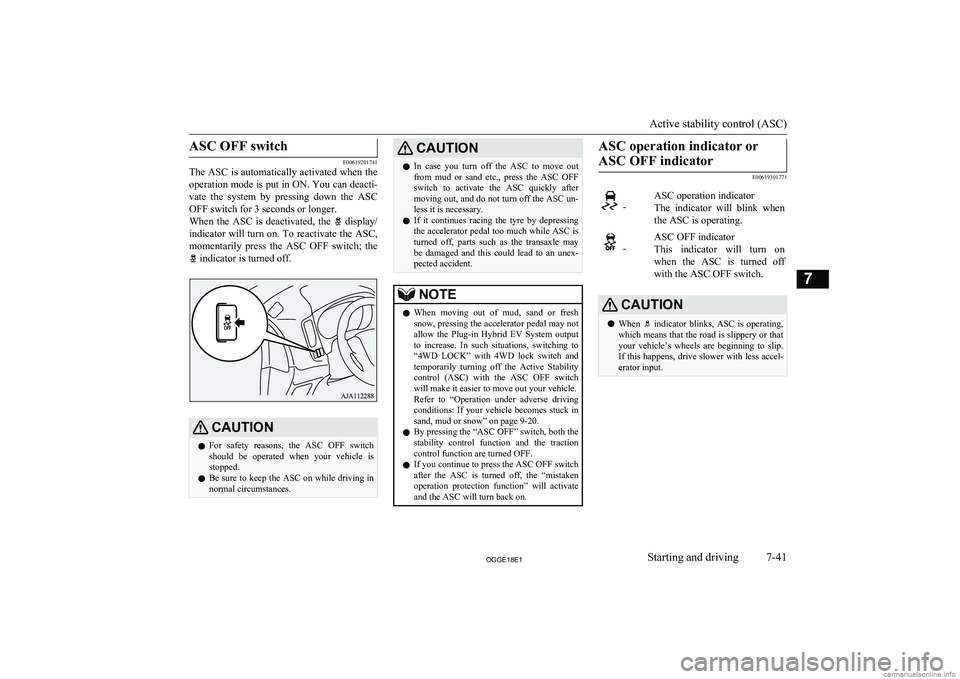
ASC OFF switch
E00619201741
The ASC is automatically activated when the
operation mode is put in ON. You can deacti-
vate the system by pressing down the ASC
OFF switch for 3 seconds or longer.
When the ASC is deactivated, the
display/
indicator will turn on. To reactivate the ASC, momentarily press the ASC OFF switch; the
indicator is turned off.
CAUTIONl For safety reasons, the ASC OFF switch
should be operated when your vehicle is stopped.
l Be sure to keep the ASC on while driving in
normal circumstances.CAUTIONl In case you turn off the ASC to move out
from mud or sand etc., press the ASC OFF switch to activate the ASC quickly after moving out, and do not turn off the ASC un-
less it is necessary.
l If it continues racing the tyre by depressing
the accelerator pedal too much while ASC is turned off, parts such as the transaxle may
be damaged and this could lead to an unex- pected accident.NOTEl When moving out of mud, sand or fresh
snow, pressing the accelerator pedal may not
allow the Plug-in Hybrid EV System output to increase. In such situations, switching to
“4WD LOCK” with 4WD lock switch and temporarily turning off the Active Stability
control (ASC) with the ASC OFF switch
will make it easier to move out your vehicle.
Refer to “Operation under adverse driving
conditions: If your vehicle becomes stuck in sand, mud or snow” on page 9-20.
l By pressing the “ASC OFF” switch, both the
stability control function and the tractioncontrol function are turned OFF.
l If you continue to press the ASC OFF switch
after the ASC is turned off, the “mistaken
operation protection function” will activate
and the ASC will turn back on.ASC operation indicator or
ASC OFF indicator
E00619301771
-ASC operation indicator
The indicator will blink when the ASC is operating. -ASC OFF indicator
This indicator will turn on
when the ASC is turned off with the ASC OFF switch.CAUTIONl When indicator blinks, ASC is operating,
which means that the road is slippery or that your vehicle’s wheels are beginning to slip.
If this happens, drive slower with less accel- erator input.
Active stability control (ASC)
7-41OGGE18E1Starting and driving7
Page 256 of 538
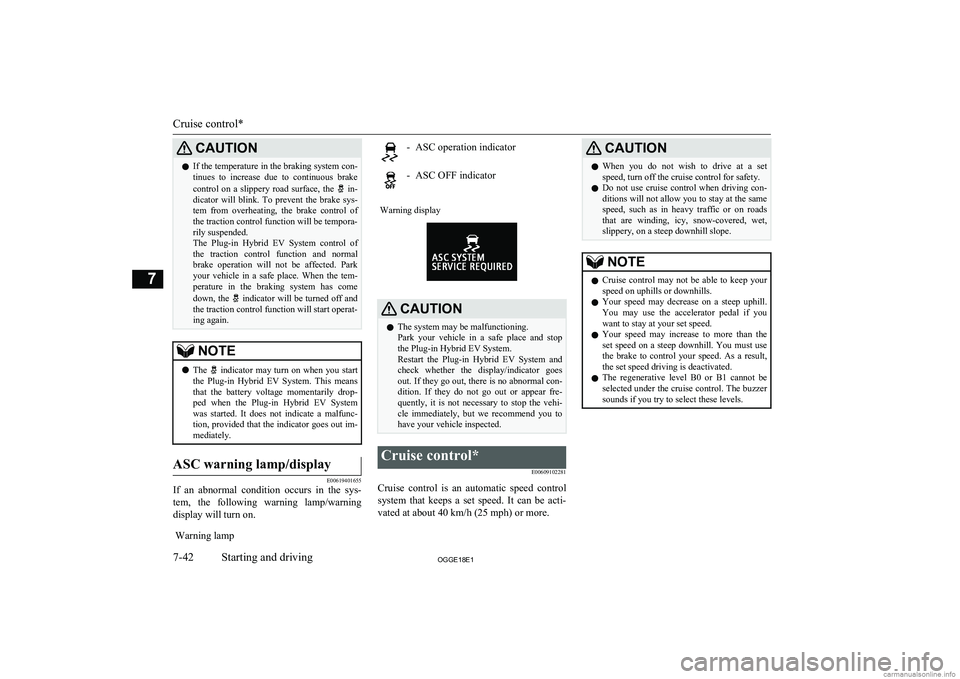
CAUTIONlIf the temperature in the braking system con-
tinues to increase due to continuous brake
control on a slippery road surface, the
in-
dicator will blink. To prevent the brake sys- tem from overheating, the brake control of the traction control function will be tempora-
rily suspended.
The Plug-in Hybrid EV System control of the traction control function and normal
brake operation will not be affected. Park your vehicle in a safe place. When the tem-
perature in the braking system has come
down, the
indicator will be turned off and
the traction control function will start operat-
ing again.
NOTEl The indicator may turn on when you start
the Plug-in Hybrid EV System. This means that the battery voltage momentarily drop- ped when the Plug-in Hybrid EV System
was started. It does not indicate a malfunc- tion, provided that the indicator goes out im-
mediately.ASC warning lamp/display
E00619401655
If an abnormal condition occurs in the sys-
tem, the following warning lamp/warning
display will turn on.
Warning lamp-ASC operation indicator-ASC OFF indicatorWarning displayCAUTIONl The system may be malfunctioning.
Park your vehicle in a safe place and stop
the Plug-in Hybrid EV System.
Restart the Plug-in Hybrid EV System and check whether the display/indicator goes out. If they go out, there is no abnormal con-
dition. If they do not go out or appear fre-
quently, it is not necessary to stop the vehi- cle immediately, but we recommend you tohave your vehicle inspected.Cruise control*
E00609102281
Cruise control is an automatic speed controlsystem that keeps a set speed. It can be acti-vated at about 40 km/h (25 mph) or more.
CAUTIONl When you do not wish to drive at a set
speed, turn off the cruise control for safety.
l Do not use cruise control when driving con-
ditions will not allow you to stay at the same
speed, such as in heavy traffic or on roads that are winding, icy, snow-covered, wet,
slippery, on a steep downhill slope.NOTEl Cruise control may not be able to keep your
speed on uphills or downhills.
l Your speed may decrease on a steep uphill.
You may use the accelerator pedal if you
want to stay at your set speed.
l Your speed may increase to more than the
set speed on a steep downhill. You must use the brake to control your speed. As a result, the set speed driving is deactivated.
l The regenerative level B0 or B1 cannot be
selected under the cruise control. The buzzer
sounds if you try to select these levels.
Cruise control*
7-42OGGE18E1Starting and driving7
Page 266 of 538
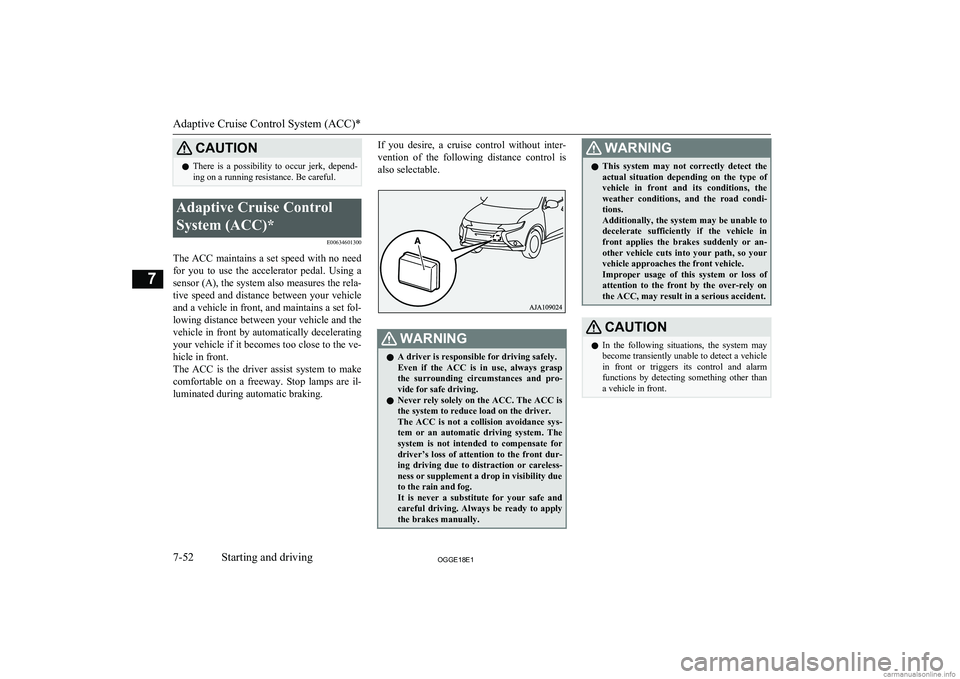
CAUTIONlThere is a possibility to occur jerk, depend-
ing on a running resistance. Be careful.Adaptive Cruise Control
System (ACC)* E00634601300
The ACC maintains a set speed with no needfor you to use the accelerator pedal. Using a
sensor (A), the system also measures the rela- tive speed and distance between your vehicle
and a vehicle in front, and maintains a set fol- lowing distance between your vehicle and thevehicle in front by automatically decelerating
your vehicle if it becomes too close to the ve-
hicle in front.
The ACC is the driver assist system to make comfortable on a freeway. Stop lamps are il-luminated during automatic braking.
If you desire, a cruise control without inter-
vention of the following distance control is
also selectable.WARNINGl A driver is responsible for driving safely.
Even if the ACC is in use, always grasp the surrounding circumstances and pro- vide for safe driving.
l Never rely solely on the ACC. The ACC is
the system to reduce load on the driver.
The ACC is not a collision avoidance sys- tem or an automatic driving system. The
system is not intended to compensate for driver’s loss of attention to the front dur-
ing driving due to distraction or careless-
ness or supplement a drop in visibility due
to the rain and fog.
It is never a substitute for your safe and careful driving. Always be ready to apply
the brakes manually.WARNINGl This system may not correctly detect the
actual situation depending on the type of
vehicle in front and its conditions, the weather conditions, and the road condi-
tions.
Additionally, the system may be unable to decelerate sufficiently if the vehicle infront applies the brakes suddenly or an-
other vehicle cuts into your path, so your vehicle approaches the front vehicle.
Improper usage of this system or loss of attention to the front by the over-rely on
the ACC, may result in a serious accident.CAUTIONl In the following situations, the system may
become transiently unable to detect a vehicle in front or triggers its control and alarm
functions by detecting something other than a vehicle in front.
Adaptive Cruise Control System (ACC)*
7-52OGGE18E1Starting and driving7
Page 267 of 538
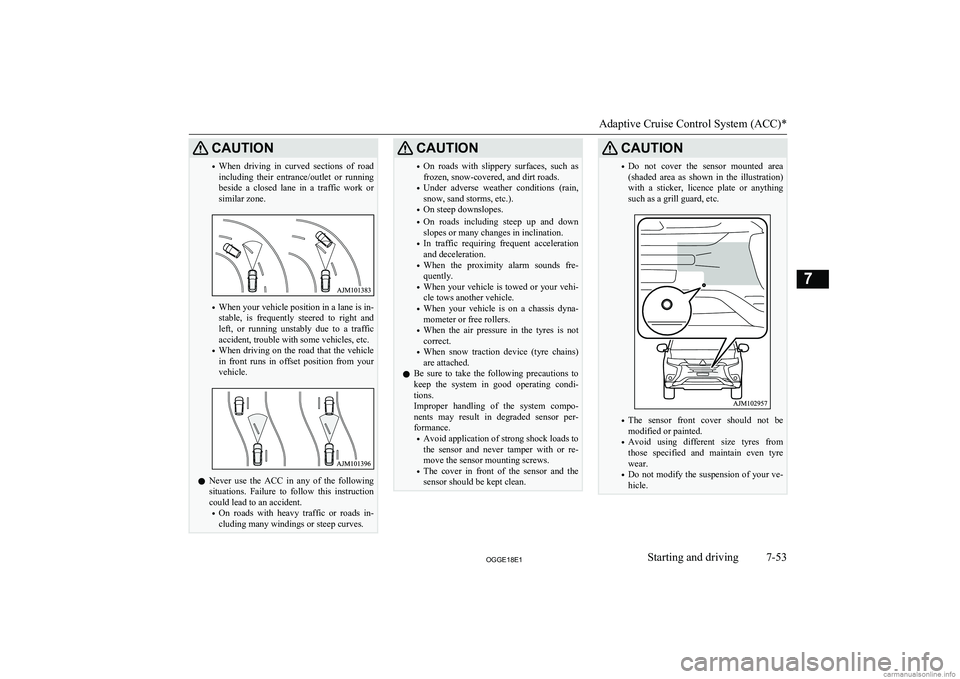
CAUTION•When driving in curved sections of road
including their entrance/outlet or running beside a closed lane in a traffic work or
similar zone.
• When your vehicle position in a lane is in-
stable, is frequently steered to right and left, or running unstably due to a trafficaccident, trouble with some vehicles, etc.
• When driving on the road that the vehicle
in front runs in offset position from your
vehicle.
l Never use the ACC in any of the following
situations. Failure to follow this instructioncould lead to an accident.
• On roads with heavy traffic or roads in-
cluding many windings or steep curves.
CAUTION• On roads with slippery surfaces, such as
frozen, snow-covered, and dirt roads.
• Under adverse weather conditions (rain,
snow, sand storms, etc.).
• On steep downslopes.
• On roads including steep up and down
slopes or many changes in inclination.
• In traffic requiring frequent acceleration
and deceleration.
• When the proximity alarm sounds fre-
quently.
• When your vehicle is towed or your vehi-
cle tows another vehicle.
• When your vehicle is on a chassis dyna-
mometer or free rollers.
• When the air pressure in the tyres is not
correct.
• When snow traction device (tyre chains)
are attached.
l Be sure to take the following precautions to
keep the system in good operating condi-
tions.
Improper handling of the system compo-
nents may result in degraded sensor per- formance.
• Avoid application of strong shock loads to
the sensor and never tamper with or re- move the sensor mounting screws.
• The cover in front of the sensor and the
sensor should be kept clean.CAUTION• Do not cover the sensor mounted area
(shaded area as shown in the illustration)
with a sticker, licence plate or anything
such as a grill guard, etc.
• The sensor front cover should not be
modified or painted.
• Avoid using different size tyres from
those specified and maintain even tyre
wear.
• Do not modify the suspension of your ve-
hicle.
Adaptive Cruise Control System (ACC)*
7-53OGGE18E1Starting and driving7
Page 278 of 538
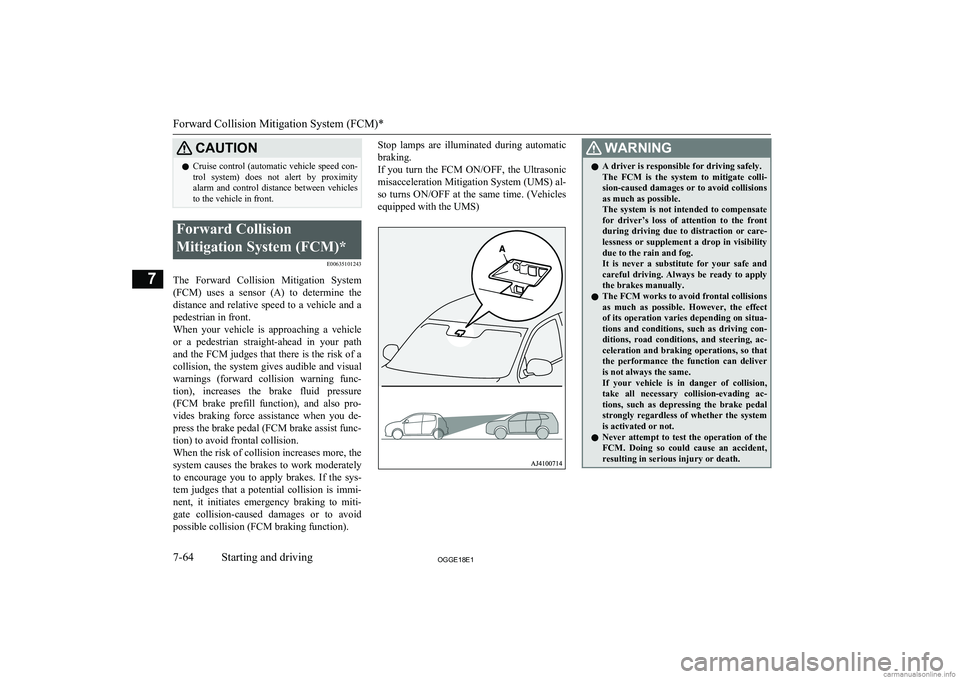
CAUTIONlCruise control (automatic vehicle speed con-
trol system) does not alert by proximity
alarm and control distance between vehicles to the vehicle in front.Forward Collision
Mitigation System (FCM)* E00635101243
The Forward Collision Mitigation System(FCM) uses a sensor (A) to determine the distance and relative speed to a vehicle and apedestrian in front.
When your vehicle is approaching a vehicle
or a pedestrian straight-ahead in your path
and the FCM judges that there is the risk of a collision, the system gives audible and visualwarnings (forward collision warning func-
tion), increases the brake fluid pressure (FCM brake prefill function), and also pro-vides braking force assistance when you de-press the brake pedal (FCM brake assist func-
tion) to avoid frontal collision.
When the risk of collision increases more, the system causes the brakes to work moderately
to encourage you to apply brakes. If the sys- tem judges that a potential collision is immi- nent, it initiates emergency braking to miti-
gate collision-caused damages or to avoid possible collision (FCM braking function).
Stop lamps are illuminated during automatic
braking.
If you turn the FCM ON/OFF, the Ultrasonic misacceleration Mitigation System (UMS) al- so turns ON/OFF at the same time. (Vehicles
equipped with the UMS)WARNINGl A driver is responsible for driving safely.
The FCM is the system to mitigate colli- sion-caused damages or to avoid collisionsas much as possible.
The system is not intended to compensate for driver’s loss of attention to the frontduring driving due to distraction or care-
lessness or supplement a drop in visibility
due to the rain and fog.
It is never a substitute for your safe and careful driving. Always be ready to apply
the brakes manually.
l The FCM works to avoid frontal collisions
as much as possible. However, the effect
of its operation varies depending on situa- tions and conditions, such as driving con-ditions, road conditions, and steering, ac-
celeration and braking operations, so that
the performance the function can deliver
is not always the same.
If your vehicle is in danger of collision,
take all necessary collision-evading ac- tions, such as depressing the brake pedal
strongly regardless of whether the system is activated or not.
l Never attempt to test the operation of the
FCM. Doing so could cause an accident,
resulting in serious injury or death.
Forward Collision Mitigation System (FCM)*
7-64OGGE18E1Starting and driving7